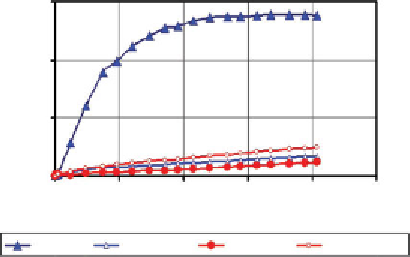Environmental Engineering Reference
In-Depth Information
150
100
50
0
0
100
200
300
400
500
EK Treatment Duration, hrs
Test anode
Control anode
Test cathode
Control cathode
Figure 2.16
Cumulative mass of ClO
4
-
removed from soil into the electrode chambers
during EK (Pamukcu and Huang, 2001)
electrical energy through the electrolysis of water, changes
in soil water chemistry and transient pressure differentials
in soil pores (Ray and Ramsey, 1987; Muraoka et al., 2011).
This experiment exemplifies one of the typical situations
where the majority of the current is carried by the ion flow
in pore fluid, and not through the double layers. Therefore,
electromigration in pore fluid becomes the dominant mech-
anism of transport.
As observed in figure 2.16, approximately 99% of the ini-
tial mass of the perchlorate (the initial perchlorate concen-
tration was 840 mg/kg) was extracted out of the sample soil
by the end of 7 days of electrokinetic treatment. The control
specimen showed less than 30% removal by diffusion for the
same duration. The rate of electrokinetic removal was signif-
icantly faster for the first three days of treatment, by the end
of which 80% of the initial mass of perchlorate was removed.
Although the soil remained conductive beyond the 3 days,
most of the current carriers in the pore fluid were depleted
during that time. The electro-osmotic flow of water contin-
ued in the positive direction (from anode to cathode) for the
first 8 days of treatment, but ceased afterwards. The average
equivalent hydraulic conductivity was computed as 1x10
-5
cm/sec, and the electro-osmotic permeability as 1.7x10
-5
cm
2
/sec/V.
C. Ammonium, NH4+ Extraction: The processed munici-
pal sludge by N-Viro Soil™ technique produces a Ca-rich

















Search WWH ::

Custom Search